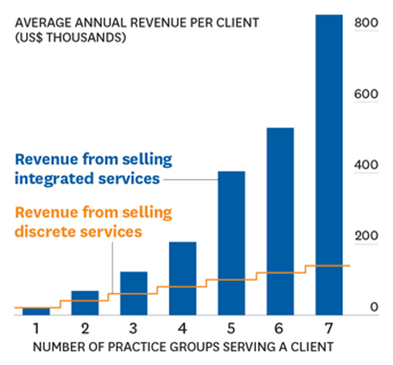To unpack this a bit, the orange line is the revenue generated by individual practice areas serving an individual client. The blue bars are the increases in firm revenue when multiple practice areas service the same client. Even if your firm does not have multiple practice areas, there is evidence showing that increasing the number of partners meaningfully serving a client increases revenue and profitability as well as building client stickiness for higher levels of retention.
So to this, partners may say, “that’s great for the firm, but what about me?” Gardner’s research goes further and demonstrates that individual rates for lawyers increase as they collaborate more and more broadly across the firm.
Now that we’ve established that strategic client management is good for clients, firms and individual practitioners, what’s involved? (and we promise it is much easier than the actual practice of law.)
Before we get to specifics (in subsequent pieces), let’s discuss some underlying principles of strategic client management:
- Cross-serving, and
- Teamwork
Cross-serving versus cross-selling
At the core of strategic client management is increasing business from current clients, be it involving more partners (or other fee earners), business professionals at the firm, additional practice areas, services or offices. This generally does not happen on its own. Firms need to make intentional efforts to expand client relationships.
In response to this, many firm leaders resort to continually exhorting their partners to “sell, sell, sell,” thinking that that will get the job done. The problem is that this falls on mostly deaf ears because most partners absolutely hate to sell (and most clients hate to be “sold.”) So, what’s to be done?
Consider cross-serving instead of cross-selling.
This is far more than a semantic difference. It’s truly a headset change: cross-serving starts with the client’s needs, cross-selling starts with the firm’s wants. Stop and think about the implications of this for a minute or so; this is counter to much advice given to law firms. Cross-selling is about getting the client to buy what your firm has to offer, regardless of their needs or how well they are being served by others. Cross-selling is basically along the lines of, “Want to meet our new tax guy?”
Cross-serving requires a bit more thought and preparation than cross-selling, making it much more effective, and, we’d think, satisfying than cross-selling. Cross-serving starts with a deep understanding of the client’s business and their priorities – and how those priorities meaningfully intersect with what your firm can provide. This will allow for the development of a sound, solutions-oriented business proposal tailored to the client’s priorities; truly serving the client; not selling.
Does this take more time and effort? Yep – it does. To quote Philip Stanhope, 4th Earl of Chesterfield, “Whatever is worth doing at all, is worth doing well.” Cross-selling is often just going through the motions; cross-serving brings something of value to clients, which will redound positively to the firm and the practitioner; building longer-term, more profitable relationships. Firms should be willing to invest in the resources to help make this happen rather than just expecting their partners to do this on their own.
Collaboration & teamwork
If not abundantly clear by now, lawyers are going to have to climb out of their self-imposed solitary confinement and work with other people. As has been recognized, in an era of increasing specialization (which is a good thing), lone practitioners simply cannot, on their own, deliver comprehensive solutions to clients. And, it’s not just teaming with other lawyers, either. Holistic solutions require intellectually-diverse, client-facing teams of lawyers and business professionals (who have expertise and credibility in highly germane areas, such as pricing, that lawyers do not). For some reason teamwork and collaboration scare the bejesus out of lawyers – which has forever baffled us (and many others smarter than we are).
In a two-part series, Lawyers and teamwork, the inestimable Bill Henderson lays out the reasons behind and plausible solutions to this evergreen issue.[5] In Part I, Bill quotes David Burgess, Publishing Director of The Legal 500, a global research company that conducts research, in part, among thousands of corporate clients each year. When asked (and I paraphrase), “What do most firms get wrong?” David answered, ““Teamwork. The clients want their outside lawyers to work together as a team—for the right hand to consistently know what the left hand is doing.”
Doesn’t seem to be an unreasonable ask; in fact it feels like a pretty low bar (and every other industry and professional service sector gets this in spades).
Again, collaboration is more than just good for the firm, it has tangible benefits to individual practitioners, as well. Another pretty dramatic data set from Heidi Gardner:




